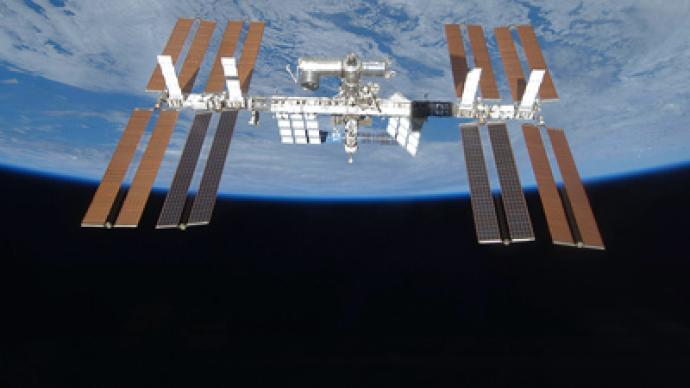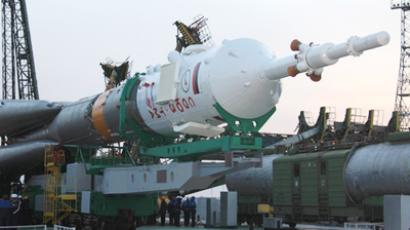Fifty years after Gagarin, US-Russian space odyssey continues

Yury Gagarin's 108-minute orbit around the Earth on April 12, 1961 captured the imagination of the entire world, while setting in motion many national and international projects to reach “the final frontier.”
The stunning achievements of the Soviet space program, which sparked a wave of panic in US academic and political circles, forced Americans to rethink the way they were approaching their studies. This national navel-gazing, however, had already started before cosmonaut Yury Gagarin arrived on the scene.Four years before Gagarin’s epic space flight, on October 4, 1957, the Soviet Union had launched Sputnik, the first Earth-orbiting artificial satellite. This successful mission provoked an avalanche of handwringing reports in the US media centered on the single question: “Why is the US educational system failing to keep pace with the Soviets?”The Cold War story of Alexei Kutzkov versus Stephen LapekasThe March 1958 issue of Life magazine featured a controversial article, entitled “Crisis in Education,” which scrutinized the academic achievements of two students, Alexei Kutzkov from Moscow and Stephen Lapekas from Chicago, both 16 years old. The Life reporters doggedly followed Kutzkov and Lapekas around their respective schools (they even managed to follow Kutzkov around Moscow), putting their noses into their extracurricular activities, and noting the differences between these young representatives from opposite sides of the ideological iron curtain. The article begins with a glowing report of the Soviet youth.“In the austere atmosphere of Moscow’s School 49, Alexei Kutzkov spends six intensive days a week on a formidable array of subjects,” the article opens. “They include Russian literature, sixth-year English, fifth-year physics, fourth-year chemistry, electrical technique, mathematics, technical drawing, machinery and astronomy.”“More than half of Alexei’s classroom time is given over to scientific subjects,” the article adds.Outside of the classroom, Alexei keeps moving “at the same determined pace,” and it should come as no surprise that his “interest in girls, by U.S. teenage standards, has been slow in developing,” which goes far at explaining the tongue-in-cheek comment that “there is no sex in the Soviet Union.” The comrades were too busy hitting the books.The assorted black-and-white photographs that accompanied the Life story, which presents Soviet Russia in a rare positive light, show Alexei participating in a wide range of cerebral activities, including working in the laboratory, reading from an English book, and contemplating his next move on the chess board. Meanwhile, Kutzkov’s impressive list of academic exertions makes his American counterpart’s school day look ordinary and almost wasteful by comparison.“Stephen Lapekas of Chicago starts out almost every school day by meeting his steady, Penny Donahue, and heading for Austin High,” the article continues, under a section entitled, ‘Relaxed Studies’. “Ten minutes later he gets to the Typing II class, slips behind a large electric typewriter and another pleasant school day begins.”The Life article was intentionally designed to set off a firecracker inside the halls of America’s sleepy, self-contented school system, and it certainly succeeded on that point. Indeed, the painful limits of Lapekas’s academic life – with so much attention being given to Typing and Dancing – makes one wonder how America ever got to the Moon just one decade later .“The intellectual application of him is moderate. In English, for example, students seldom bother to read assigned books and sometimes make book reports based on comic book condensations. Stephen’s extracurricular activities [he is described as the school’s “star swimmer,” and a “leader in student affairs”]…leave him little time for hard study.” In an article following the Kutzkov-Lapekas matchup, the novelist Sloan Wilson slammed the disastrous condition of the US public school system, yet these are criticisms would not seem out of place today.“A surprisingly small percentage of high school students is studying what used to be considered standard subjects,” Sloan wrote. “Only 12% are taking any mathematics more advanced than algebra, and only 25% are studying physics. A foreign language is studied by fewer than 15% of the students.”He even lamented that so many Russians were studying English, but not the other way around.“Ten million Russians are studying English,” Wilson wrote, “but only 8,000 Americans are studying Russian.”Then, next to an illustration of two teenagers dancing in front of a jukebox, with a teacher attempting to offer them a pile of books, Wilson wrote, quoting a junior high school teacher, “students nowadays are smothered with anxious concern, softened with lack of exercise, then flung into the morass of excessive sex interest…They are overfed and underworked. They have too much leisure and too little discipline.”The same complaints are regularly heard today.Space Race takes offAlthough the official start of the Space Race between the two superpowers happened in 1955, when both sides announced their intention to launch satellites into Earth’s orbit, the Soviet’s no-nonsense approach to education hit a raw nerve in US academic circles. As a result, US school curricula began to reflect the prioritization of math and scientific studies. The results of this change of academic priorities, together with advances in ballistic missile research, allowed US President John F. Kennedy to announce the goal of putting a man on the Moon “before this decade is out.”"I believe that this nation should commit itself to achieving the goal,” Kennedy said in an address to a special joint session of Congress in May, 1961, “before this decade is out, of landing a man on the moon and returning him safely to the earth."That ambitious goal was reached on July 20, 1969 with the Moon landing of the Apollo 11.The US space program has witnessed its fair share of historic accomplishments, including the implementation of the Space Shuttle program, which since 1981 has had 135 launches. This year, however, fifty years after Yury Gagarin became the first man in space, “the US space shuttle program is winding down leaving former rival Russia as the only nation able to carry astronauts into orbit,” the Associated Press reported.NASA is now forced to rely on Russian Soyuz capsules to deliver its astronauts to the International Space Station – “to the tune of $50 million per seat until a new shuttle is ready,” the AP report continues.Presently, the United States is facing huge budget deficits (fighting three wars will do that) and can ill afford to foot the bill for ambitious space projects. And though Washington’s Cold War rivalry with the Soviets has disappeared, China is showing tremendous promise on the space front.Meanwhile, a fierce battle is being waged in many US states, which are attempting to balance their books by cutting back on spending on public education.Although US president Barack Obama has promised not to let this happen, his track record of keeping his promises leaves a lot to be desired. On Sunday, the White House announced that $13 billion would be cut from the departments of Education, Labor, and Health and Human Services. Early Tuesday morning, the House Appropriations Committee released a detailed listing of the educational agencies scheduled to take a hit, including “Literacy Through School Libraries, the National Writing Project, International Education and Foreign Language, AmeriCorps and programs to mentor the children of prisoners,” according to the Washington Times.While the US space program has hit the skids, and is now forced to hitch a ride to the stars with Russian assistance, it is clearly not time for Russia to plant a flag and proclaim the galactic mountaintops.Svetlana Savitskaya, who flew two space missions in 1982 and 1984 and became the first woman to make a spacewalk, criticized the government’s handling of space programs following the 1991 collapse of the Soviet Union."Cosmonautics in my opinion is one of the rare if not the only thing in our country today that is still left that our people can be proud of in this country,” Savitskaya told reporters at Moscow's Space Memorial Museum. “There's nothing new to be proud of [in the realm of space exploration] the last 20 years. Thank God, it has been preserved, this is a thing to be proud of, that at least it has been preserved.”Savitskaya, however, said she was confident that “we'll create something new."Meanwhile, Russian President Dmitry Medvedev, expressing his pride that a Soviet was the first person to travel into outer space, said he is confident man will eventually conquer other planets, in an interview with China Central Television. “I believe it was a truly revolutionary event, a highly symbolic one. It was a tremendous achievement of Soviet cosmonautics, which divided the world into ‘before’ and ‘after the flight’, what has been termed the ‘space era’”, the Russian leader said.An unintended consequence of space travelMeanwhile, there is one ironic legacy of man’s space flights that goes to often unmentioned: appreciation for the Earth. An unintended outcome of the Cold War Space Race is that it helped introduce the modern environmental movement. As astronauts and cosmonauts journeyed deep into outer space, they sent back to Earth first-ever photographs of the Earth as it appears from the heavens. The first remarkable pictures show a fragile blue sphere bordered by the blackness of outer space.So perhaps the greatest lesson we may learn from Gagarin’s epic space voyage is that although space is a tempting place, it is only Earth where man can truly call his home. Thus, it would speak far better of the human species if we were to use the tremendous strides that we have made in the fields of math and science to finding ways of saving the planet, not destroying it in yet another maddening "race."Otherwise, there will be no future generations of children to pass along the stories of our amazing accomplishments, like Yury Gargarin’s first-ever space journey, and America’s Apollo mission to the Moon. To access the 1958 Life magazine story in its entirety,click hereRobert Bridge, RT














